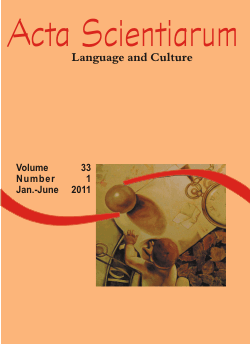<b>De-metaphorizing and becoming animal: when the animal looks back. A reading of Marian Engel’s <em>Bear</em></b> - doi: 10.4025/actascilangcult.v33i1.6251
Resumo
The primacy acquired by nature in our current culture has given way to several issues not strictly connected with an immediate and ‘purely’ ecological interest: there is rather the need to question how we conceive the animal with a focus on the possibility to transcend Western cultural heritage. When trying to give a literary representation of the animal, it is particularly important to adopt some measures which, following the trajectory of a genuine, positive ‘becoming-animal’, will safeguard its independence and avoid reducing it to metaphorically anthropomorphic representations. This essay intends to underline how, from this viewpoint, a few novels coming from the post-colonial area, where animal tales often show how interwoven humans and animals are and how they are constructed in relation to each other supply interesting case studies. My interest focuses particularly on Canadian Marian Engel’s Bear, where the writer tries to deal with unspeakable subjects between a woman and a bear: through an act of radical approach to its physical reality, the former comes first to recognize the latter, and then to accept its Otherness. On its side, the bear seemingly ‘shows’ a post-colonial attitude subversively resisting a typically Western anthropomorphic allegorization. Holding fast to itself and its animality, choosing in a way to ‘stay mute’, the bear keeps the role of a ‘perceptive catalyst’, ‘thought-producing’ and thus ‘world-changing’, according to an aesthetics of perception suggesting that the animal gaze might be the best perspective from which to observe not only our world, but especially our own selves.Downloads
DECLARAÇÃO DE ORIGINALIDADE E DIREITOS AUTORAIS
Declaro que o presente artigo é original, não tendo sido submetido à publicação em qualquer outro periódico nacional ou internacional, quer seja em parte ou em sua totalidade.
Os direitos autorais pertencem exclusivamente aos autores. Os direitos de licenciamento utilizados pelo periódico é a licença Creative Commons Attribution 4.0 (CC BY 4.0): são permitidos o acompartilhamento (cópia e distribuição do material em qualqer meio ou formato) e adaptação (remix, transformação e criação de material a partir do conteúdo assim licenciado para quaisquer fins, inclusive comerciais.
Recomenda-se a leitura desse link para maiores informações sobre o tema: fornecimento de créditos e referências de forma correta, entre outros detalhes cruciais para uso adequado do material licenciado.




















6.png)









